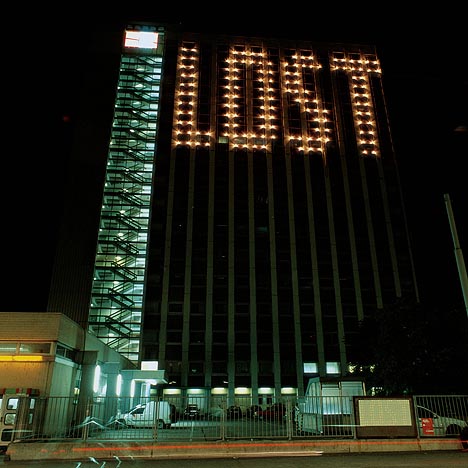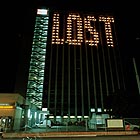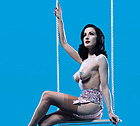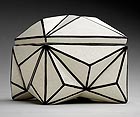
translated and summarized by: Liz Wollner-Grandville,
English summary July 20 - 25
< rotor >: selected: 10 Years of < rotor >
It’s like home
Exhibitions marking an anniversary carry the risk of having an inferior concept and displaying self-adulation. But not so in , aptly described - at its opening by co-curator Lejla Hodzic - as the place in which many people – artists, curators, those interested in art - feel at home. primarily focuses on the artists and their work, and thereby conveys a sense of home. And Margarete Makovec and Anton Lederer are the hosts whose wholehearted dedication bestows this exhibition its continuity.
While wandering through the exhibition, which is arranged in accordance with the spatial settings and not by chronological order, and consisting of the individual displays and projects of , one enjoys meeting old acquaintances. The presentation includes works by the Graz03 project “Balkan Konsulat” and “real*utopia”, Sejla Kameric’s “homeSICK” or Constantin Luser’s “Lichtschreibmaschine”, as well as Christian Eisenberger's “Corpus Deluxe”, originating from a cooperation with the Schauspielhaus in Graz, or Ivan Moudov’s “Traffic Control”, created during the project “Never Stop the Action” during the steirische herbst 2001. Isa Rosenberger’s video “Sarajevo Guided Tours”, which emerged from an Artist-In-Residence exchange with Kristina Leko, was already displayed in other contexts and institutions, similar to Esra Ersen’s video “Brothers and Sisters”, which was part of the “Exciting Europe” exhibit at the Gallery for Contemporary Art in Leipzig.
Not only the relationship to Graz is documented in , but also the numerous national and international guest performances and the network, which has formed in the past 10 years – bet it to art institutions or artists. And if the city council for cultural affairs in Graz is frustrated when he hears the remark: “We already did it. We are doing it”, as an answer to his suggestions and ideas of cultural work, than all that is left to do, is to congratulate.
By Nora Theiss
8020 Graz, Belgiergasse 8, until 31.07.09
rotor.mur.at
Salzburger Kunstverein: Pawel Ksiazek
Internet mannerisms
Admittedly: The idea to download pictures from the “net” is not really new. With the aim to use them as patterns for a general kind of artistic access, and anonymously. Inspired by the bonus of the largest supply of pictures of all time and all worlds, as generally phrased. Just as easily accessible as permissive, even if the access is sometimes restricted, old aunty Internet.
Who has to bustle on the borders and fringes of human existence. And who then unexpectedly, and increasingly, attain an unimagined popularity. Buzzword: coma boozing. High in alcohol content and – Absolut! – pits. On a kind of senior trip, recurring every weekend, destination: Nirvana. When the party will have irrevocably ended.
But all this can be well worth seeing in the works by Polish painter Pawel Ksiazek. His works shown at the Salzburger Kunstverein (and during the so-called Festival-time) include the most lurid headlines about the nocturnal fright before and the horror on the morning after, in a panorama of abysmal panel paintings. “N.N. vs Artists” presents the maltreated young amidst their own disgraced objects. In the digitalized dilemma of filth and neglect: the trophies of a victorious past, almost buried under the rubble of addiction and booze. Or a snapshot during a comatose snooze, with a champagne bottle still in mouth … uncontrolled. Uninhibited. Weak-willed. Babylon of the texted shots of the omnipresent and omnipotent cell phone.
Controversial? Shocking? Yes and no. Because: it’s all sealed in the dusty topics and techniques of the workshops of seemingly old masterly small masters. Almost grandfatherly. Where, much too quickly, relational closeness to relatives is dug up in art history, and can be found there.
The Internet – inexhaustible shelter of a completely hyped-up mannerism and its figurines contorted beyond all recognition, of a revolving and turning (away) body? In the critical attitudes towards society represented by Viennese Actionism – or the current tendency towards the performative (example: Abu Ghraib).
Even laying the track of the eruptive expressive seems to originate from the stocks of a calculated / digitalized gesture of the colour toner than something which has become notoriously “authentic.”
But: they are not as incredibly faceless, as sex, violence and a good mood attempt to convey by their globalized dissemination. Even the anonymous has a name. His name. Something one had to find out under different circumstances, in a rather painful experience in relatively luckless introductory conversations….
By Stephan Maier
Salzburger Kunstverein, Künstlerhaus
5020 Salzburg, Hellbrunnerstrasse 3, until 13.09.09
www.salzburger-kunstverein.at
Neue Galerie am Landesmuseum Joanneum: Robert Wilson – VOOM Portraits
The magic of animated pictures
If an all-rounder like Robert Wilson – director, choreographer, playwright, painter, curator, light designer, stage designer, and architect – starts working, there is a lot to be expected. The current series of VOOM video portraits offers impressive and intensive images and sound.
The entire upper floor of the Neue Galerie is darkened, and you are welcomed by magically attuning sound effects. In most rooms only one “picture” is mounted, which strongly influences the overall effect. This mixture of tone and sounds – Wilson worked with the musicians Tom Waits, Lou Reed, and Marianne Faithfull - and the lighting of the picture boxes, turns the walk through the gallery into a ride in the ghost train. One is physically under tension and intently expecting something eerie looming around the corner.
The portraits of celebrities are reminiscences and references to pictures from movies, art history, but also “autobiographical, sociografical and epochal”, as Peter Weibel writes in the accompanying text, but never clearly attributable to a single original, but always a mixture of various sources. Caroline of Monaco is transformed into her own mother in “To Catch a Thief” and at the same time the portrait reminds of John Singer Sargent’s “Portrait of Madame X” (1884), John Buscemi, standing in front of the butcher’s bench, mimes a scene from “The Cook, the Thief, his Wife and her Lover” by Peter Greenaway and at the same time reveals characteristics of Dracula. Johnny Depp poses as Rrose Sélavy in a drag queen costume and Brad Pitt stand in the rain in his underwear.
Animals also become protagonists in Wilson’s portraits. The mirror hall impresses with a rhythmic series of colourful horn frog portraits - accompanied by Johann Sebastian Bach.
By Nora Theiss
Neue Galerie am Landesmuseum Joanneum
8010 Graz, Sackstrasse 16, until 06.09.09
www.neuegalerie.at
WAGNER:WERK Museum Postsparkasse: cubiCZmus! The deconstruction of Modernism in Prague
Ashes and Diamonds
The delicate Belle-Époque-lady on the poster doesn’t really match the architecture in the background. The Kurhaus placed into the Bohemian Lázné Bohdanec by Josef Gocár is unbelievable. The fact that it resembles a silent-movie set of the early twenties is based on the easy stylistic applicability of Bohemian architectural Cubism, which of course had a bigger picture in mind: the return of pure material to crystal-prismatic basic forms. It’s all about the definition of a specific Czech style, supported by Otto Wagner students, who adamantly opposed his claim for material justice
“A bowl or a can offered the opportunity of simple dramatic situations, actions, and scopes, which allowed us to realize the cubistic view and the extent of the material”, said Pavel Janák – This was the alternative for not being able to go ahead with an entire building such as the Prague “Diamond House”. A selection of these expressive cans, crystalline cookie jars, folded closets, and cubistic urns are now displayed at the PSK, which was able to draw on the top class collection of the Museum of Applied Arts in Prague. While the objects are adequately presented in Gocár’s House of the Black Madonna, their combination with the dematerialized architecture of Otto Wagner in Vienna offers an exciting interaction.
Legs are folded, facades are creased and drawers expressively shifted, everything seems frozen in grotesque dance poses. To secure the objects the harassed carpenters had to implement additional stiffeners. Nourished by Bohemian Gothic and its tendency to negate statics.
Architectural Cubism became the nucleus of the Czech work federation of architects and artists, which a few years later merged into the Bohemian Functionalism. Gocárs “Grand Café” in the House of the Black Madonna was carefully reconstructed a few years ago and is just as popular as the replicas of cookie jars and ashtrays, which are sold in the shop. 100 years after its foundation, Czech Cubism is a significant part of architectural history.
By Iris Meder
WAGNER:WERK Museum Postsparkasse
1018 Vienna, Gerog-Coch-Platz 2, until 29.08.09
www.ottowagner.com
Mehr Texte von translated and summarized by: Liz Wollner-Grandville


 Teilen
Teilen





